- Goal
SpringBoot에서 mybatis에 DB를 여러개 사용하기 위한 설정
- Time
30min
- Enviroment
java 1.8, springboot 1.5.2
- Tutorial
개발을 하다보면 데이터베이스를 여러개 운영 해야하는 경우가 생긴다. mybatis를 이용할 경우 설정하는 방법인데, 결론적으로는 마음에 들진 않는다.
JPA로 설정하는법은 아래 포스팅을 참고
2017/03/24 - [Springboot] - [springboot] jpa multiple datasource
우선 기본적으로 application.properties에 DB정보를 작성한다. 편의를 위해 DB는 H2를 사용한다.
# DB1
spring.db1.datasource.driverClassName=org.h2.Driver
spring.db1.datasource.url=jdbc:h2:~/db1
# DB2
spring.db2.datasource.driverClassName=org.h2.Driver
spring.db2.datasource.url=jdbc:h2:~/db2
그다음 JAVA로 DB를 설정해 준다.
첫번째 DB 설정
- @MapperScan 에 scan할 package명을 작성 해 주고 sqlSessionFactoryBean.setMapperLocations에 mapper에 위치를 작성해 준다.
- 첫번째 db에 경우 @Primary 어노테이션을 붙여 준다.
package com.example.config;
import javax.sql.DataSource;
import org.apache.ibatis.session.SqlSessionFactory;
import org.mybatis.spring.SqlSessionFactoryBean;
import org.mybatis.spring.SqlSessionTemplate;
import org.mybatis.spring.annotation.MapperScan;
import org.springframework.beans.factory.annotation.Qualifier;
import org.springframework.boot.autoconfigure.jdbc.DataSourceBuilder;
import org.springframework.boot.context.properties.ConfigurationProperties;
import org.springframework.context.ApplicationContext;
import org.springframework.context.annotation.Bean;
import org.springframework.context.annotation.Configuration;
import org.springframework.context.annotation.Primary;
@Configuration
@MapperScan(value="com.example.dao1", sqlSessionFactoryRef="db1SqlSessionFactory")
public class Db1DatabaseConfig {
@Bean(name = "db1DataSource")
@Primary
@ConfigurationProperties(prefix = "spring.db1.datasource")
public DataSource db1DataSource() {
return DataSourceBuilder.create().build();
}
@Bean(name = "db1SqlSessionFactory")
@Primary
public SqlSessionFactory db1SqlSessionFactory(@Qualifier("db1DataSource") DataSource db1DataSource, ApplicationContext applicationContext) throws Exception {
SqlSessionFactoryBean sqlSessionFactoryBean = new SqlSessionFactoryBean();
sqlSessionFactoryBean.setDataSource(db1DataSource);
sqlSessionFactoryBean.setMapperLocations(applicationContext.getResources("classpath:mybatis/db1/*.xml"));
return sqlSessionFactoryBean.getObject();
}
@Bean(name = "db1SqlSessionTemplate")
@Primary
public SqlSessionTemplate db1SqlSessionTemplate(SqlSessionFactory db1SqlSessionFactory) throws Exception {
return new SqlSessionTemplate(db1SqlSessionFactory);
}
}
두번째 DB설정
- 이름만 살짝살짝 다르고 @Primary 어노테이션이 빠진다.
package com.example.config;
import javax.sql.DataSource;
import org.apache.ibatis.session.SqlSessionFactory;
import org.mybatis.spring.SqlSessionFactoryBean;
import org.mybatis.spring.SqlSessionTemplate;
import org.mybatis.spring.annotation.MapperScan;
import org.springframework.beans.factory.annotation.Qualifier;
import org.springframework.boot.autoconfigure.jdbc.DataSourceBuilder;
import org.springframework.boot.context.properties.ConfigurationProperties;
import org.springframework.context.ApplicationContext;
import org.springframework.context.annotation.Bean;
import org.springframework.context.annotation.Configuration;
@Configuration
@MapperScan(value="com.example.dao2", sqlSessionFactoryRef="db2SqlSessionFactory")
public class Db2DatabaseConfig {
@Bean(name = "db2DataSource")
@ConfigurationProperties(prefix = "spring.db2.datasource")
public DataSource db2DataSource() {
return DataSourceBuilder.create().build();
}
@Bean(name = "db2SqlSessionFactory")
public SqlSessionFactory db2SqlSessionFactory(@Qualifier("db2DataSource") DataSource db2DataSource, ApplicationContext applicationContext) throws Exception {
SqlSessionFactoryBean sqlSessionFactoryBean = new SqlSessionFactoryBean();
sqlSessionFactoryBean.setDataSource(db2DataSource);
sqlSessionFactoryBean.setMapperLocations(applicationContext.getResources("classpath:mybatis/db2/*.xml"));
return sqlSessionFactoryBean.getObject();
}
@Bean(name = "db2SqlSessionTemplate")
public SqlSessionTemplate db2SqlSessionTemplate(SqlSessionFactory db2SqlSessionFactory) throws Exception {
return new SqlSessionTemplate(db2SqlSessionFactory);
}
}
첫번째 DB mapper interface를 작성해 준다.
- 조회 말고도 테스트를 위해 몇가지를 더 추가해 주었다.
package com.example.dao1;
import org.apache.ibatis.annotations.Insert;
import org.apache.ibatis.annotations.Select;
public interface Db1Mapper {
@Select("SELECT count(*) FROM MEMBER")
public String getCount();
@Insert("INSERT INTO MEMBER (NAME) VALUES (#{name})")
public void insertMember(String name);
public String getDb1Dual() throws Exception;
public void createTbl();
}
두번째 DB mapper insterface 작성
- 이름만 다르고 내용은 같다.
package com.example.dao2;
import org.apache.ibatis.annotations.Insert;
import org.apache.ibatis.annotations.Select;
public interface Db2Mapper {
@Select("SELECT count(*) FROM MEMBER")
public String getCount();
@Insert("INSERT INTO MEMBER (NAME) VALUES (#{name})")
public void insertMember(String name);
public String getDb2Dual() throws Exception;
public void createTbl();
}
서비스를 작성해 준다.
- 마찬가지로 테스트를 위한 코드가 추가되어있다.
package com.example.service;
import org.springframework.beans.factory.annotation.Autowired;
import org.springframework.stereotype.Service;
import org.springframework.transaction.annotation.Transactional;
import org.springframework.transaction.interceptor.TransactionAspectSupport;
import com.example.dao1.Db1Mapper;
import com.example.dao2.Db2Mapper;
@Service
public class DbService {
@Autowired
Db1Mapper db1Mapper;
@Autowired
Db2Mapper db2Mapper;
/* select dual */
public String getDb1Dual() throws Exception{
return db1Mapper.getDb1Dual();
}
/* select dual */
public String getDb2Dual() throws Exception{
return db2Mapper.getDb2Dual();
}
@Transactional
public void transactionTest(boolean exceptionFlag ) {
db1Mapper.insertMember("test");
System.out.println("db1 count=" + db1Mapper.getCount());
db1Mapper.insertMember("test");
System.out.println("db2 count=" + db1Mapper.getCount());
if( exceptionFlag ){
TransactionAspectSupport.currentTransactionStatus().setRollbackOnly();
}
}
}
controller를 작성. 서비스를 테스트코드로 작성해도 되지만 내용이 얼마 안되니 controller에서 테스트
package com.example.controller;
import org.springframework.beans.factory.annotation.Autowired;
import org.springframework.stereotype.Controller;
import org.springframework.web.bind.annotation.RequestMapping;
import org.springframework.web.bind.annotation.ResponseBody;
import com.example.service.DbService;
@Controller
public class DbController {
@Autowired
DbService dbService;
@RequestMapping("/")
public @ResponseBody String root_test() throws Exception{
return "Hello World";
}
@RequestMapping("/db1")
public @ResponseBody String db1() throws Exception{
return dbService.getDb1Dual();
}
@RequestMapping("/db2")
public @ResponseBody String db2() throws Exception{
return dbService.getDb2Dual();
}
@RequestMapping("/transaction")
public @ResponseBody String transaction() throws Exception{
dbService.transactionTest(true);
// rollback
System.out.println("- rollaback");
dbService.transactionTest(false);
return "ok";
}
}
main class에 기본데이터 셋팅부분을 추가
- 처음 실행시 테이블 생성, transaction 테스트용
package com.example;
import org.springframework.beans.factory.annotation.Autowired;
import org.springframework.boot.CommandLineRunner;
import org.springframework.boot.SpringApplication;
import org.springframework.boot.autoconfigure.SpringBootApplication;
import com.example.dao1.Db1Mapper;
import com.example.dao2.Db2Mapper;
@SpringBootApplication
public class SpringbootMybatisMultiDatasourceApplication implements CommandLineRunner{
@Autowired
private Db1Mapper db1Mapper;
@Autowired
private Db2Mapper db2Mapper;
public static void main(String[] args) {
SpringApplication.run(SpringbootMybatisMultiDatasourceApplication.class, args);
}
@Override
public void run(String... args) throws Exception {
System.out.println("table create");
db1Mapper.createTbl();
db2Mapper.createTbl();
System.out.println("table search");
System.out.println("db1 count=" + db1Mapper.getCount());
System.out.println("db2 count=" + db2Mapper.getCount());
}
}
프로그램을 실행한 후
- localhost:8080/db1
- localhost:8080/db2
- localhost:8080/transaction
'Programming > Springboot' 카테고리의 다른 글
| [springboot] jar 실행시 profile 선택 (0) | 2019.01.09 |
|---|---|
| [springboot] springboot + spring security + jpa + thymeleaf (1) | 2017.06.15 |
| [springboot] springboot starter maven dependency (0) | 2017.03.27 |
| [springboot] jpa multiple datasource (0) | 2017.03.24 |
| [springboot] h2 console 사용하기 (0) | 2017.03.22 |

